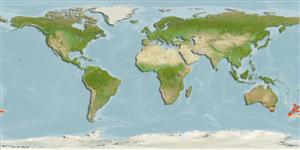>
Gadiformes (Cods) >
Moridae (Morid cods)
Etymology: Pseudophycis: Greek, pseudes = false + Greek, phykon = seaweed; because of the habit of living among them (Ref. 45335).
Eponymy: Bacchus was the Roman god of wine. Forster used a variant spelling of the name. (Ref. 128868), visit book page.
More on author: Forster.
Environment: milieu / climate zone / Tiefenbereich / distribution range
Ökologie
seewasser; brackwasser demersal; tiefenbereich 26 - 700 m (Ref. 58489), usually 200 - 300 m (Ref. 54741). Subtropical; 33°S - 50°S, 137°E - 177°E (Ref. 54741)
Southwest Pacific: New Zealand and around Australia, at least from Sydney to Adelaide, and around Tasmania. Often confused with Pseudophycis barbata (Ref.9563).
Length at first maturity / Size / Gewicht / Alter
Geschlechtsreife: Lm 52.0, range 45 - 55 cm
Max length : 90.0 cm TL Männchen/unbestimmt; (Ref. 1371); common length : 55.0 cm TL Männchen/unbestimmt; (Ref. 9258)
Rückenflossenstacheln (insgesamt) : 0; Afterflossenstacheln: 0. Nostrils anterior to eye by about one-third of snout length. Pyloric caeca 6 to 8. Color reddish pink becoming paler ventrally, vertical fins with dark margins; a dark black blotch on the pectoral fin base.
Body shape (shape guide): fusiform / normal; Cross section: oval.
Found usually on soft muddy or sandy bottoms. Also on rocky bottoms, in estuaries, bays and continental shelf (Ref. 9563). In New Zealand, most abundant in 200 to 300 m along the edge of the continental shelf. May be found at depths exceeding 700 m (Ref. 9258). Feeds primarily on fishes, cephalopods, crabs and other crustaceans. Utilized as frozen fillets as well as fish blocks; eaten steamed, fried, microwaved and baked (Ref. 9988).
Cohen, D.M., T. Inada, T. Iwamoto and N. Scialabba, 1990. FAO species catalogue. Vol. 10. Gadiform fishes of the world (Order Gadiformes). An annotated and illustrated catalogue of cods, hakes, grenadiers and other gadiform fishes known to date. FAO Fish. Synop. 125(10). Rome: FAO. 442 p. (Ref. 1371)
IUCN Rote Liste Status (Ref. 130435: Version 2025-1)
Bedrohung für Menschen
Harmless
Nutzung durch Menschen
Fischereien: hoch kommerziell; Sportfisch: ja
Tools
Zusatzinformationen
Download XML
Internet Quellen
Estimates based on models
Preferred temperature (Ref.
123201): 7.9 - 13.5, mean 11 °C (based on 43 cells).
Phylogenetic diversity index (Ref.
82804): PD
50 = 0.6250 [Uniqueness, from 0.5 = low to 2.0 = high].
Bayesian length-weight: a=0.00589 (0.00301 - 0.01154), b=3.12 (2.94 - 3.30), in cm total length, based on LWR estimates for this species & (Sub)family-body (Ref.
93245).
Trophic level (Ref.
69278): 3.9 ±0.6 se; based on diet studies.
Widerstandsfähigkeit (Ref.
120179): mittel, Verdopplung der Population dauert 1,4 - 4,4 Jahre. (K=0.4(?); tm=4; Fec~1million).
Prior r = 0.42, 95% CL = 0.27 - 0.62, Based on 5 data-limited stock assessments.
Fishing Vulnerability (Ref.
59153): Low to moderate vulnerability (35 of 100).
🛈
Climate Vulnerability (Ref.
125649): High to very high vulnerability (71 of 100).
🛈
Nutrients (Ref.
124155): Calcium = 56.8 [23.8, 116.8] mg/100g; Iron = 1.16 [0.65, 2.15] mg/100g; Protein = 19.6 [17.4, 21.5] %; Omega3 = 0.412 [0.214, 0.763] g/100g; Selenium = 47.5 [24.4, 100.0] μg/100g; VitaminA = 8.47 [2.69, 27.87] μg/100g; Zinc = 0.562 [0.389, 0.809] mg/100g (wet weight); based on
nutrient studies.
